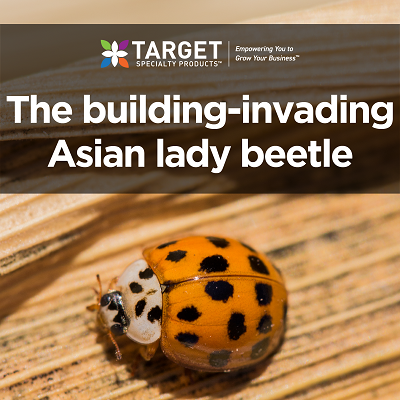
The Asian ladybeetle, typically a beneficial garden insect, will alter its behavior as the mild climates across North America descend into winter temperatures. They are hard-driven to seek hibernation areas to wait out the cold until spring weather allows them to emerge again. Depending on the timing of the cold weather onset, nuisance pests such as Asian lady beetles, may remain active well into November and early December in some areas.
Often referred to as an occasional invader, alongside the notorious brown-marmorated stink bug and boxelder bug, the Asian ladybeetle will invade homes and businesses in the fall. These pests will “overwinter” in buildings, hiding inside of walls, under siding, and in other voids. They will remain until spring, when warmer temperatures lure them back to their natural habitat.
Take advantage of the warmer pest seasons by encouraging your customers and prospects to get preventative treatments and services before these beetles begin to gather with the cooling weather, eliminating the opportunity for pests to overwinter in the area.
What You Should Know About the Asian LadyBeetle
The Asian ladybeetle may look like an average ladybug at first glance, but its behavior and some features are quite different. It is differentiated by the distinct “M” or “W” shape marking on the back of its head; a slightly larger, oval shaped body; and, its lack of brilliant red coloring. Not to mention, it has the potential to bite. However, their bite is harmless and feels like a pin prick, often occurring as they seek food and moisture in the dry fall and winter months.
The Asian ladybeetle is an introduced nuisance pest. It is known for leaving behind excrement stains on walls, ceilings and furniture, and emitting a foul odor when disturbed. In the rare cases where infestations reach into the hundreds and even thousands, the Asian lady beetle’s secretions have been known to cause respiratory issues and eye irritation for some people.
On a positive note, there’s no need to worry about them growing their population while they’re overwintering. Reproduction and egg laying only occur in the spring, once they’ve returned to their natural habitat.
Understanding the Asian ladybeetle's behaviors and knowing their seasonality will help you to determine the best course of action for treating and preventing future infestations.
How to Treat Asian LadyBeetlesin the Fall
On sunny Fall days, Asian ladybeetles can often be found on the southwest walls of buildings, absorbing the warmth of the sun. During these final days of fall, it’s not too late to apply an exterior residual treatment.
In treating, focus on the perimeters of likely entry points such as doors, windows, soffits, attic vents, and eaves. In addition to pesticide treatments, you can take advantage of the warmer weather to implement building exclusion — sealing up any entry points where insects might gain access.
As long as they haven’t begun their overwinter descent, you can still work on your prevention efforts. However, once Asian ladybeetles do make their way inside the walls and ceilings of homes and businesses, there is very little you can do to treat them. Advise your customer to be diligent about vacuuming them up. In the spring, you can return to provide exclusion.
Asian LadyBeetlePrevention: It’s a Spring Thing
With their ability to fly and squeeze into the smallest of openings, preventing Asian ladybeetles from gaining access to the inside of a structure can seem like a daunting task. However, it can and should be done. With a thorough inspection, the right equipment and a good understanding of the surrounding environment, you can perform a structural exclusion service that will keep Asian ladybeetles and other pests outside where they belong.
If you’re performing exclusion in the spring, make sure you wait until late spring before you begin sealing any cracks, crevices, or other openings. This will allow for any seasonal stragglers to emerge from their overwintering sites. Begin your exterior treatment by sealing up any holes and crevices, and checking these likely entry points for tears and gaps:
- Screens
- Doors
- Windows
- Skylights
- Exterior vents
- Exterior utility lines
- Soffits
- Attic vents
With crevices and holes sealed up, and tears and gaps repaired, you can assure your customer that an Asian ladybeetle invasion in the fall should no longer be a concern.
Educate About the Importance of Prevention and Exclusion
Although Asian ladybeetles are an occasional invader, informing your customers and prospects about the health risks and unsightly excretions they leave behind should encourage them to consider an annual preventative treatment plan and exclusion service.
Let your customers know your business can help manage Asian ladybeetles during peak seasons and before overwintering. You can look through your customers’ records to see which accounts have had issues in the past and offer a preventative checkup or exclusion service for a charge in late summer.
Target Specialty Products has been helping pest control professionals reduce Asian ladybeetle populations for 80 years. If you need assistance with selecting a product, contact us here, we have 43 active locations across the country with representatives ready to provide their expertise and support. For direct inquiries, visit us here.

